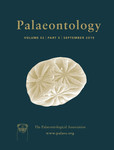Reg. Charity No. 1168330

Ostracods are common yet understudied prey item in the fossil record. We document drill holes in Paleocene (Danian) ostracods from central Argentina using 9025 specimens representing 66 species. While the percentage of drilled specimens at assemblage‐level is only 2.3%, considerable variation exists within species (0.3–25%), suggesting prey preference by the drillers. This preference is not determined by abundance because no significant correlation is found between species abundance and drilling percentages. Seven methods were used, some of which are new, to quantify drilling percentages for the abundant and commonly drilled Togoina argentinensis. The resulting range, from 9.9% to 14.6%, suggests that drilling percentages are fairly insensitive to the method used, implying that comparisons across studies are possible. This information, combined with data from the literature, suggests the Cretaceous–Palaeogene mass extinction may have had a limited effect on drilling intensity in ostracods. The cylindrical (Oichnus simplex) and parabolic (O. paraboloides) drill holes from Argentina may have been caused primarily by naticid and possibly muricid gastropods. Two oval drill holes (O. ovalis) are morphologically similar to octopod drill holes, but their small size, the fact that extant octopods are not known to drill ostracods and the absence of such holes in co‐occurring gastropods, preclude ascription to a predator clade. Drill holes are located preferentially in the median and dorsal regions, where most soft tissue, including the adductor muscle, is located. Drilled specimens are statistically taller than non‐drilled specimens for T. argentinensis and larger predators selected larger ostracods. The drilling percentage does not significantly differ in ornamented ostracods.